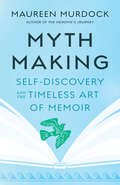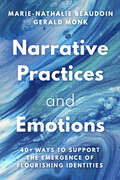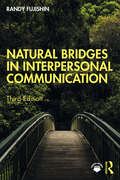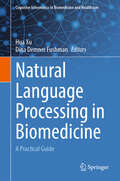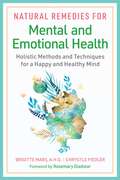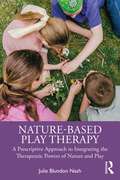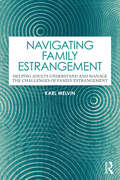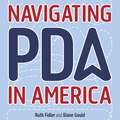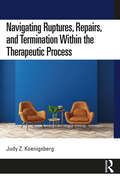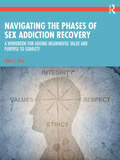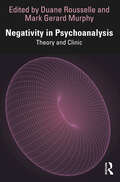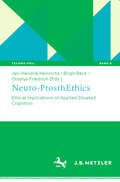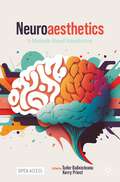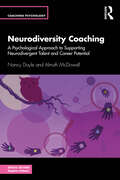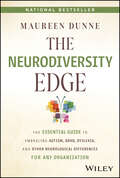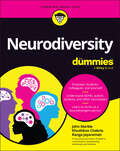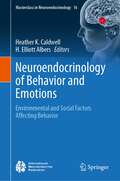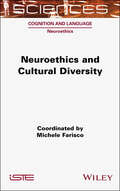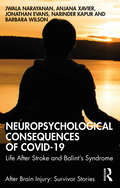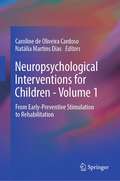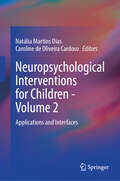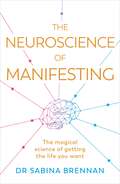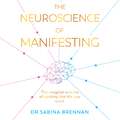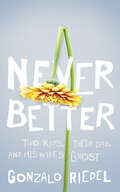- Table View
- List View
Mythmaking: Self-Discovery and the Timeless Art of Memoir
by Maureen MurdockBest-selling Heroine&’s Journey author Maureen Murdock invites readers to explore their personal story within the rich tapestry of human experience by examining the craft of memoir alongside fresh writing advice and prompts.Maureen Murdock looks at thematic connections between ancient myths and contemporary memoirs to probe questions like: What is my journey? Where is home? Her background as a Jungian psychotherapist enriches her teaching—urging us to dig deep to identify our own universal archetypes.Writers who feel stuck or unworthy of writing about themselves will find thought-provoking inspiration and validation in this book, while those simply looking to use writing as a tool for self-exploration will examine their patterns and stories to reveal their true inner selves. And all will be left with a deeper understanding of the rich scope of the memoir genre by exploring contemporary favorites—like Terry Tempest Williams&’s Refuge, Joan Didion&’s The Year of Magical Thinking, and David Carr&’s The Night of the Gun—from a mythological perspective.Like myth, memoir reveals a unity to human experience that ultimately we all share similar hopes, dreams, and desires as well as fears, losses, and heartbreaks. Memoir helps writers understand the trajectory of their lives and helps readers better grasp our own place within the human experience.
Narrative Practices and Emotions: 40+ Ways to Support the Emergence of Flourishing Identities
by Marie-Nathalie Beaudoin Gerald MonkContemporary challenges and discoveries call for an expansion of narrative therapy practices. Narrative therapy has the potential to help clients understand their challenges as separate from their selves, shifting the focus to their inner strengths when managing a problem. Narrative Practices and Emotions provides a fresh perspective for new and experienced practitioners alike on how to combine classic narrative therapy with the latest scholarship on the mind–body connection. Authors Marie-Nathalie Beaudoin and Gerald Monk tap into cutting edge discoveries on mindfulness, interpersonal neurobiology, and positive psychology. Each chapter offers a wealth of clinical questions and embodied exercises, while “conversation maps”—which provide important guideposts to practitioners—are illustrated with engaging transcripts of therapeutic work. These compelling case studies elegantly demonstrate how skillful conversations can invigorate hope and support personal development. Readers will discover a wide variety of ways to assist clients of all ages in reengaging with a meaningful life and sustaining well-being.
Natural Bridges in Interpersonal Communication
by Randy FujishinWith a particularly student-friendly and engaging style, this third edition gives readers the fundamental tools necessary to effectively communicate in interpersonal interactions. Natural Bridges in Interpersonal Communication, Third Edition, is a concise and practical book that introduces students to the basic concepts and skills of interpersonal communication in both face-to-face and online interactions in personal and professional settings. Each chapter features human interest stories and review exercises to help students better understand the concepts covered. This edition continues its expanded coverage of foundational research and devotes additional space to discussions of cultural safety, race and ethnicity, issues of mental health, and technology and social media. This textbook is designed for communication studies, business, and career and trade courses in interpersonal communication and communication skills at the community college and four-year university levels. Online instructor materials that accompany the book include an instructor’s manual, sample exams, and a sample class schedule. They are available at www.routledge.com/9781032355054.
Natural Language Processing in Biomedicine: A Practical Guide (Cognitive Informatics in Biomedicine and Healthcare)
by Hua Xu Dina Demner FushmanThis textbook covers broad topics within the application of natural language processing (NLP) in biomedicine, and provides in-depth review of the NLP solutions that reveal information embedded in biomedical text. The need for biomedical NLP research and development has grown rapidly in the past two decades as an important field in cognitive informatics. Natural Language Processing in Biomedicine: A Practical Guide introduces the history of the biomedical NLP field and takes the reader through the basic aspects of NLP including different levels of linguistic information and widely used machine learning and deep learning algorithms. The book details common biomedical NLP tasks, such as named entity recognition, concept normalization, relation extraction, text classification, information retrieval, and question answering. The book illustrates the tasks with real-life use cases and introduces real-world datasets, novel machine learning and deep learning algorithms, and large language models. Relevant resources for corpora and medical terminologies are also introduced. The final chapters are devoted to discussing applications of biomedical NLP in healthcare and life sciences. This textbook therefore represents essential reading for students in biomedical informatics programs, as well as for professionals who are conducting research or building biomedical NLP systems.
Natural Remedies for Mental and Emotional Health: Holistic Methods and Techniques for a Happy and Healthy Mind
by Brigitte Mars Chrystle FiedlerA self-care guide to treating mental, emotional, and neurological conditions• Explores common mental health concerns and stress-related issues—such as anxiety, depression, anger, insomnia, brain fog, and trauma—and shares remedies and practices to address and heal their root causes • Examines the influence of diet and nutrition on mental health and the benefits of specific foods, herbs, supplements, essential oils, and self-care techniques • Details holistic remedies for neurological conditions, such as ADHD, epilepsy, addiction, bipolar disorder, PTSD, multiple sclerosis, Parkinson&’s disease, traumatic brain injury (TBI), and stroke Mental health and emotional well-being are just as important as physical health. And like physical health, there are many simple ways to improve and support mental wellness with the healing power of herbs and other holistic remedies and practices. In this comprehensive guide to natural methods to maintain a healthy mind, herbalist Brigitte Mars and natural health expert Chrystle Fiedler explore many common mental health concerns and stress-related issues—such as anxiety, depression, panic attacks, anger, insomnia, brain fog, and trauma—and share remedies and practices to address and heal their root causes. Citing recent medical studies, they examine the influence of diet and nutrition on mental health concerns and explore the benefits of specific foods, herbs, supplements, essential oils, and self-care techniques like acupressure, massage, and color therapy. The authors also explore holistic practices and treatments for moving through grief, breaking free from addiction, working with ADHD and epilepsy, supporting chronic conditions like bipolar disorder, PTSD, and Parkinson&’s disease, and recovering from traumatic brain injury (TBI) and stroke. Presenting a wealth of holistic self-care therapies for mental well-being, emotional balance, and neurological health, this guide enables each of us to heal the mind and nurture the soul, two essential keys to a happy, joyful life.
Nature-Based Play Therapy: A Prescriptive Approach to Integrating the Therapeutic Powers of Nature and Play
by Julie Blundon NashNature-Based Play Therapy brings a theoretical basis to arguments for including nature in play therapy and provides tools for that inclusion with a prescriptive model. Throughout this book, play therapists are introduced to the histories of nature and play across cultures and cultural expectations and are then guided into an understanding of how nature and play intersect with current trends in society and psychotherapy. Readers will learn about how the therapeutic powers of play are activated and facilitated by the inclusion of nature in play therapy, and they will be taken step-by-step through a prescriptive case conceptualization model. They’ll also find case studies that link theoretical tenets, the therapeutic powers and play and nature, and intended treatment outcomes. Nature-Based Play Therapy is an excellent introduction to a vital and growing area of the field, one that gives a well-rounded summary to a theoretically based model of treatment.
Navigating Family Estrangement: Helping Adults Understand and Manage the Challenges of Family Estrangement
by Karl MelvinFamily estrangement and the stigma attached to it are complex phenomena affecting a great number of people in various ways. In response, Navigating Family Estrangement offers a deep dive into the reality of being estranged in contemporary society.This practical guide looks at how to effectively help estranged adults achieve better outcomes from a variety of perspectives. The author explores the difficulties of working with estrangement, including professional roadblocks such as the six biases that prevent connecting with a client's experience. He delves into the unique seven-step Estrangement Inquiry Model that aims to provide important insight into a client's family history, map out the present estrangement dynamic, and highlight the types of interventions to support their needs. Combining research from a range of different fields with the author's decade of clinical experience, the book is supplemented with five comprehensive case studies to demonstrate the practical strategies that address estrangement challenges.This book offers a clear and collaborative approach to a topic that will be relevant for a range of professionals, including psychotherapists, psychologists, counsellors and social workers.
Navigating PDA in America: A Framework to Support Anxious, Demand-Avoidant Autistic Children, Teens and Young Adults
by Ruth Fidler Diane GouldAlthough Pathological Demand Avoidance (PDA) has been a recognized autistic profile in the UK for some time, awareness is still growing in America. When parents first learn about it they talk about having a lightbulb moment of understanding their child better. Many described how, having found traditional parenting and behavioral techniques made things worse instead of better, they felt judged and alone. Teachers and school administrators also reported struggling to support their PDA students. The children, teens and young adults themselves were often left feeling misunderstood.The authors of this book explain PDA with an emphasis on promoting well-being both for PDA individuals and all those who support them. They provide a neurodiversity-affirming framework for supporting anxious, demand avoidant individuals across a range of settings and services. As awareness spreads across the pond, the compassion and clarity in this book will become a valuable guide to many.
Navigating Ruptures, Repairs, and Termination Within the Therapeutic Process
by Judy Z. KoenigsbergThis book explores the importance of the therapeutic relationship, the tensions or disagreements that may emerge during a therapy session, and how they can be repaired.Dr. Koenigsberg introduces a two-part transtheoretical, psycholinguistic model which focuses on the connection between ruptures and the termination phase of therapy, emphasizing the verbal and nonverbal nuances of language, to understand what is happening in the therapeutic alliance. With a reliance on psycholinguistic elements, this model can guide therapists who wish to reduce the premature termination of patients from therapy. Written in an accessible format, it provides case examples, including the patient’s and therapist’s inner experiences, and defines and describes the phases of therapy so that difficult transitions in the therapeutic process can be navigated with skill and compassion.This text is essential for providing early career as well as more seasoned therapists with excellent strategies to repair their therapeutic relationships with clients.
Navigating the Phases of Sex Addiction Recovery: A Workbook for Adding Meaningful Value and Purpose to Sobriety
by Allan J. KatzDesigned for use with clients recovering from sex addiction, this book guides readers through discovering the essential skills for their sober journey and find meaning and purpose in life through character development and emotional maturity, while improving their relationship with healthy intimacy. This workbook answers the question, “I’m sober, now what?”. It contains concise exercises and take the readers on a journey that will give them an insight into what is holding them back from a life worth living, finally living in serenity, learning the art of surrender, and finding true hope and freedom in recovery. With alternating chapters presenting problems and solutions, this workbook is designed to lead the reader through the stages of recovery while gaining skills in mindfulness, emotional regulation, and impulse control.
Negativity in Psychoanalysis: Theory and Clinic
by Duane Rousselle Mark Gerard MurphyNegativity in Psychoanalysis examines the role of negativity in psychoanalytic theory and its application in clinical settings. While theories around negativity and death drive have become routinized within philosophical interpretations of Freudian and Lacanian psychoanalysis, they often mask an inherent positivity. This volume assembles highly esteemed psychoanalytic theorists and clinicians for an in-depth discussion on the topic. It features comprehensive introductions to Freudian and Lacanian perspectives, alongside contemporary clinical and cultural issues. The book also investigates how psychoanalytic negativity influences and is influenced by social, theological, and philosophical dialogues. This work will prove invaluable for practicing psychoanalysts and those in training, while also appealing to academics and scholars in critical and cultural theory, continental and post-continental philosophy, and sociology, especially those whose research intersects clinical and theoretical traditions.
Neuro-ProsthEthics: Ethical Implications of Applied Situated Cognition (Techno:Phil – Aktuelle Herausforderungen der Technikphilosophie #9)
by Jan-Hendrik Heinrichs Birgit Beck Orsolya FriedrichThe volume focusses on the ethical dimensions of the technological scaffold embedding human thought and action, which has been brought to attention of the cognitive sciences by situated cognition theories. There is a broad spectrum of technologies co-realising or enabling and enhancing human cognition and action, which vary in the degree of bodily integration, interactivity, adaptation processes, of reliance and indispensability etc. This technological scaffold of human cognition and action evolves rapidly. Some changes are continuous, some are eruptive. Technologies that use machine learning e.g. could represent a qualitative leap in the technological scaffolding of human cognition and actions. The ethical consequences of applying situated cognition theories to practical cases had yet to find adequate attention and are elucidated in this volume.
Neuroaesthetics: A Methods-Based Introduction
by Tudor Balinisteanu Kerry PriestThis open access neuroaesthetics textbook, the first in the world, is designed for teaching a semester module (14 meetings) to undergraduate/masters students from both the sciences and the humanities. Written in a style that appeals to humanities students without prior science training, and to science students without prior humanities training, the textbook contains 6 Units, material for an introductory class, and summative comments to be discussed in a closing meeting. Each Unit comprises an overview designed as student home reading, a lecture, and a lab. The labs contain detailed step-by-step instructions for running a basic experiment and analysing the collected data, that can be easily implemented in humanities and science departments alike. The textbook introduces students to philosophical considerations of neuroaesthetics topics in context of the history of empirical aesthetics, showcases experimental approaches to the empirical study of dance, the visual arts, and music, and supports hands-on training in experimental research methods.
Neurodiversity Coaching: A Psychological Approach to Supporting Neurodivergent Talent and Career Potential (Coaching Psychology)
by Almuth Mcdowall Nancy DoyleNeurodiversity Coaching demystifies the themes and assumptions affecting neurodivergent coachee experiences at work, whilst at the same time exploring the necessary safeguards required for working with this vulnerable group. The book supports existing coaching practitioners, managers and community leaders to understand the essentials of neurodivergence, a term which encompasses ADHD, autism, dyslexia, dyspraxia and Tourette Syndrome, and how these diagnoses require specific coaching approaches to support individuals to thrive at work. This book is practically focused on the “how”, sharing coaching exercises and activities that have been evaluated and researched by authors with extensive experience in the field. Grounded in coaching psychology theory, those with existing knowledge will be able to transfer their skill set to the neurodiversity context and those who are considering learning more about coaching can be signposted to essential knowledge and skills. Neurodiversity Coaching will be suitable for independent coaching practitioners and internal organisational coaches and managers seeking a coaching approach.
Neurodiversity Coaching: A Psychological Approach to Supporting Neurodivergent Talent and Career Potential (Coaching Psychology)
by Nancy Doyle Almuth McDowall- neurodiversity coaching is an emerging field, the topic of neurodiversity has been increasing in the past decade and general awareness is growing - this book will be the first, broad publication on neurodiversity coaching - uses science-based methodology
The Neurodiversity Edge: The Essential Guide to Embracing Autism, ADHD, Dyslexia, and Other Neurological Differences for Any Organization
by Maureen DunneIn The Neurodiversity Edge, renowned Oxford-trained cognitive scientist, neurodiversity expert, and business leader, Dr. Maureen Dunne presents a pioneering framework to harnessing the power of neurodiversity to navigate the most important human resources revolution in the modern era. Did you know that an estimated 1 in 5 people are “neurodivergent”—have a mind that works differently, such as the autistic, ADHDers, the dyslexic, synesthetes, and other unique neurotypes—and that the vast majority are motivated, capable, and unemployed? This indispensable guide is based on more than two decades of immersive cognitive science research, case studies, stories from neurodivergent voices, in-the-trenches work with hundreds of organizations from start-ups to global Fortune 500 titans, and Dr. Dunne's own lived experiences as a neurodivergent employer, entrepreneur, board member, and CEO. Too many unique minds and perspectives on the sidelines, and too many organizations beset by groupthink, innovation-stagnation, and a lack of access to qualified new candidates. The Neurodiversity Edge takes you all the way from why to what and to how, delivering practical insights that build on a new foundational framework: Cultivate a values-driven approach to building a culture of sustained authentic inclusion where everyone can thrive, How to improve the interview process to avoid missing game-changing talent Develop a hybrid office protocol that works for everyone and a support infrastructure that aligns with universal design principles Discover why Google's Project Aristotle found that innovation and performance hinge on psychological safety Uncover and eliminate the destructive influence of unconscious cognitive biases Take a graphic tour into the wonders of the human mind Understand unique problem-solving abilities such as lateral thinking, visual-spatial thinking, multisensory thinking, leaps of creative insight, hyperfocus, and many more How to articulate and implement organizational goals and measure progress toward them The Neurodiversity Edge is an essential guide for executives, board directors, human resources professionals, managers, recruiters, entrepreneurs, venture capitalists, allies, educators, nonprofit leaders, and anyone with an interest in better understanding neurodiversity, authentic neuroinclusion, and the human mind.
Neurodiversity For Dummies
by John Marble Khushboo Chabria Ranga JayaramanA quick and easy way to understand neurodiversity as written by neurodivergent people and our families Neurodiversity For Dummies is your essential guide in understanding neurodivergent conditions like autism, ADHD, dyslexia, and more. This quick and easy guide is perfect for anyone needing to know more about neurodiversity. And that’s all of us—because recent estimates say that 15-20% of the world’s population have some form of neurodivergence. Your life is filled with neurodivergent people that you know and love, whether you realize it yet or not. It’s time to learn to support and include the neurodivergent among us, and to understand how neurodiversity impacts society and the workplace. This is for the neurodivergent person wanting to thrive in life, for parents and caregivers seeking success for their child, and for teachers who are working to make a difference in their students’ lives. Filled with practical advice, Neurodiversity for Dummies also provides a helping hand to service providers, assistance for workplace managers and colleagues, and understanding for family members and friends. Imagine a world where we all understood ourselves better and appreciated more deeply the differences in others. No matter how your own brain thinks, Neurodiversity for Dummies is for you. Check out this jargon-free introduction for an essential overview. Explore the Spectrum of Neurodiversity: Understand in plain language the world of autism, ADHD, dyslexia, and other neurodivergent conditions. Unlock Hidden Talents: Move yourself beyond common myths and misconceptions to discover how neurodiversity actually works. Learn how neurodiversity has always been with us, why society needs neurodivergent traits, and how neurodiversity can be a wellspring of innovation, creativity, and out-of-the-box thinking. Discover Yourself: Whether you are a neurodivergent person or not, learn how to understand your own normalcy, advocate for your needs, and build meaningful connections with those who think and experience the world differently than you. Change the World Around You: Be empowered through simple steps you can take to create inclusive environments for neurodivergent individuals in your school or workplace. Uncover proven strategies that cultivate a culture of acceptance and respect, where the unique perspectives of all individuals are valued and celebrated. We believe in providing parents with better supports, empowering individuals with information, and shaping a world where we are all seen and understood. With an author team composed of neurodivergent individuals and parents writing together, Neurodiversity for Dummies is an example of the power of neurodiversity when put into action. It’s why we wrote this for you. Don’t miss your chance to embark on this transformative journey. Order your copy of Neurodiversity for Dummies now to better understand yourself and others, and to join the movement that is revolutionizing how we understand and support the diversity of the human mind.
Neuroendocrinology of Behavior and Emotions: Environmental and Social Factors Affecting Behavior (Masterclass in Neuroendocrinology #16)
by Heather K. Caldwell H. Elliott AlbersThis volume highlights current research on how the neuroendocrine system helps to influence emotional states and ultimately behavioral output. Social relationships and context-appropriate behavioral responses are important for the survival of most vertebrate species. These relationships can range from transient social interactions to strong social bonding between sexual partners and social behaviors can be observed and evaluated from the individual- to the group-level. Further, behavioral output is shaped by complex interactions between the physical environment, genetics, experience, and context, and are often modulated by the neuroendocrine system. In this book, experts in the field will provide a sweeping look at novel research in the neuroendocrine regulation of important behaviors ranging from parental care to social homeostasis, with a focus on comparative studies across vertebrate species. The first part of the book is dedicated to theneuroendocrinology of relationships, including the coordination of acoustic signals in songbirds, the complexity of social relationships in primates, and cooperation and parenting in humans. The second part of the book focuses on social behaviors and provides some insights into their regulation, including the neuroendocrine regulation of maternal behavior in rodents, the roles of oxytocin and vasopressin in the modulation of sex-specific social behavior, the interactions between adult neurogenesis, the neuroendocrine system and social behavior, and a consideration of neuroendocrine influences on reproductive decision making across species. The book concludes with a section on environmental influences on neuroendocrine systems underlying behavior, including how social isolation and endocrine disrupting chemicals affect the neuroendocrinology of behavior and emotions. Given its breadth, this volume is appropriate for undergraduate students, graduate students, postdoctoral researchers, and established researchers who are interested in neuroendocrinology and behavior. This is the sixteenth volume in the International Neuroendocrine Federation (INF) Masterclass in Neuroendocrinology series, which aims to illustrate the highest standards and highlight the latest technologies in basic and clinical research and aspires to provide inspiration for further exploration into the exciting field of neuroendocrinology.
Neuroethics and Cultural Diversity
by Michele FariscoThere is a growing discussion concerning the relationship between neuroethical reflections and cultural diversity, which is among the most impactful factors in shaping neuroethics, both as a scientific discipline and a social enterprise. The impacts of culture on science and its public perception are particularly relevant to neuroethics, which aims to facilitate the creation of an interface between neuroscience and society at large. Time is ripe for neuroethics to review the influence of the culturally specific contexts from which it originated (i.e. North America and Western Europe) and to also include other cultural perspectives in the discussion. This book illustrates a convergent approach among different cultures in identifying the main issues raised by neuroscience and emerging technologies. This should be taken as a starting point for advancing in the search for shared solutions, which are, if not definitive, at least sufficiently reliable to be translated into democratic deliberative processes.
Neuropsychological Consequences of COVID-19: Life After Stroke and Balint's Syndrome (ISSN)
by Jwala Narayanan Anjana Xavier Jonathan Evans Narinder Kapur Barbara WilsonNeuropsychological Consequences of COVID-19 focuses on Anjana’s journey as a COVID survivor following a brain injury that left her with a very rare neuropsychological syndrome called Balint’s syndrome, a disorder associated with difficulties in visual and spatial coordination. It is also the first book of its kind to provide a first-hand account from India on surviving brain injury, from diagnosis, recovery and rehabilitation, providing the therapeutic milieu in the Indian context and exploring cultural influences on rehabilitation.Written jointly by Anjana, her neuropsychologist and the international experts in the field of neuropsychology who were also involved in her diagnosis and care, the book highlights how COVID-19, a virus primarily affecting the respiratory system, can also result in a disabling brain injury. It describes Anjana’s recovery and the rehabilitation she received and provides a deeper understanding of this experience of a very rare condition through the views of Anjana herself. In addition, Anjana’s rehabilitation journey stumbles upon many important themes of rehabilitation including cultural sensitivity, personal identity, resilience, role of family and rehabilitation in a low to middle income country.This book is valuable reading for clinical and neuropsychologists, neurologists, other rehabilitation therapists including physiotherapists, occupational therapists, nurses and social work professionals, particularly those interested in cross cultural rehabilitation. It will also be of interest to students in these fields.
Neuropsychological Interventions for Children - Volume 1: From Early-Preventive Stimulation to Rehabilitation
by Caroline de Oliveira Cardoso Natália Martins DiasThis book is the first of two volumes that aim to serve as a comprehensive guide for professionals working with neuropsychological interventions especially designed for children. This first volume presents the theoretical foundations, tips and guidelines for neuropsychologists to develop different interventions, such as stimulation and early intervention with a focus on promoting neuropsychological health; habilitation, appropriate for work with neurodevelopment disorders; and rehabilitation, in cases of structural alterations. In this sense, it reflects the editors' concern to provide material with practical tips, but theoretically grounded, and truly useful to professionals in clinical and also school contexts. This first volume is divided into two parts. The first addresses the theoretical and practical foundations of child neuropsychological assessment and intervention. Neuropsychological assessment is discussed, with a focus on its role in guiding intervention. Also, different types of interventions are presented, and a taxonomy is offered, according to its differential objectives of promotion or remediation and the target population (typical development, functional or structural alterations of the Nervous System), leading to the suggestion of three types of interventions in neuropsychology in both clinical and school contexts: 1) Early preventive Intervention; 2) Habilitation and 3) Rehabilitation. Cognitive stimulation in different contexts, such as school, family and clinical, is also discussed, exploring how teachers and parents can also collaborate in intervention processes, expanding the possibilities for action beyond the clinical context. A section concludes by addressing the importance of the feedback and the neuropsychological assessment report.The second part focuses specifically on stimulation and rehabilitation, offering chapters that target specific skills such as attention, memory, executive functions and academic skills, among others. The chapters summarize evidence, bring tips and illustrate existing materials and programs, in a continuous articulation between theory-evidence-practice. Originally published in Portuguese and now available in English, Neuropsychological Interventions for Children – Volumes 1 and 2 will be of interest to professionals working with neuropsychology in clinical and school contexts. It will also be useful in neuropsychology teaching contexts (specialization courses in neuropsychology and related areas) and for students and professionals in interface areas, such as Psychology, Education, Speech Therapy, Occupational Therapy among others. The translation of the original Portuguese version of this book into English was done with the help of artificial intelligence. A subsequent human revision was done primarily in terms of content.
Neuropsychological Interventions for Children - Volume 2: Applications and Interfaces
by Caroline de Oliveira Cardoso Natália Martins DiasThis book is the second of two volumes that aim to serve as a comprehensive guide for professionals working with neuropsychological interventions especially designed for children. This second volume complements the theoretical and practical foundations presented in the first volume by presenting applications to different clinical conditions and by exploring interfaces of neuropsychology with other areas of research and practice. Chapters in this second volume are divided into two parts. The first part presents a series of case studies, illustrating the practice and experience of neuropsychological rehabilitation and habilitation in different clinical conditions. The second part brings together chapters that discuss the interfaces of neuropsychology with different areas, which can use its knowledge and interventions (such as school neuropsychology) or which can be used as strategies within neuropsychological intervention or even compose inter and transdisciplinary partnerships in the work of promotion, stimulation, or cognitive remediation, such as the use and role of music, games and play, mindfulness, and transcranial direct current stimulation. So, chapters in this second part highlight the interfaces with other approaches, knowledges or disciplines. Originally published in Portuguese and now available in English, Neuropsychological Interventions for Children – Volumes 1 and 2 will be of interest to professionals working with neuropsychology in clinical and school contexts. It will also be useful in neuropsychology teaching contexts (specialization courses in neuropsychology and related areas) and for students and professionals in interface areas, such as Psychology, Education, Speech Therapy, Occupational Therapy among others. The translation of the original Portuguese version of this book into English was done with the help of artificial intelligence. A subsequent human revision was done primarily in terms of content.
The Neuroscience of Manifesting
by Dr Sabina BrennanDiscover the magical science of getting the life you want In The Neuroscience of Manifesting, psychologist and neuroscientist Dr Sabina Brennan uses cutting edge research to demonstrate that the power to manifest the life of our dreams resides within us all. By grounding key manifestation principles in science, Dr Brennan shows that manifesting does not require blind trust or faith in higher powers. Instead, it requires changing how you think and behave, and learning how to harness the power of your brain. Through breaking down complicated neuroscience into empowering everyday strategies, this book will show you how to:- Gain clarity on what you really want - Cultivate more self-compassion- Connect with your true self- Take considered action to bring about the change you desire-Create your best life using effective, scientifically grounded techniques
The Neuroscience of Manifesting
by Dr Sabina BrennanDiscover the magical science of getting the life you want In The Neuroscience of Manifesting, psychologist and neuroscientist Dr Sabina Brennan uses cutting edge research to demonstrate that the power to manifest the life of our dreams resides within us all. By grounding key manifestation principles in science, Dr Brennan shows that manifesting does not require blind trust or faith in higher powers. Instead, it requires changing how you think and behave, and learning how to harness the power of your brain. Through breaking down complicated neuroscience into empowering everyday strategies, this book will show you how to:- Gain clarity on what you really want - Cultivate more self-compassion- Connect with your true self- Take considered action to bring about the change you desire-Create your best life using effective, scientifically grounded techniques
Never Better: Two Kids, Their Dad, and His Wife's Ghost
by Gonzalo RiedelHis wife died before their second son turned one. How can he keep her memory alive when there’s so much he wants to forget?There was a time before his wife got sick when Gonzalo could think about other things. They had full lives where death didn’t factor. Where humour was more than a coping mechanism. Life wasn’t all about treatments and recovery, or the emptiness he felt when she died.They had kids together. Young kids. Less than a year after their youngest was born and suddenly he was strapping them both into their car seats to drive to their mother’s funeral.He used to think he was the glue holding the household together. It didn’t take long for him to realize how wrong he’d been. A grieving husband is in no condition to raise kids alone. There were times when he wanted to toss himself into a raging river that would suck him under and bash his skull on the rocks. That’s always an option for another day. For now, he’ll just squash those feelings and drive the kids to daycare.Does it get easier? Of course. But not right away. They say that hope only comes at the end of a long dark journey, but that isn’t entirely true because the journey never really ends. But that means there’s good news: hope is everywhere you look.
